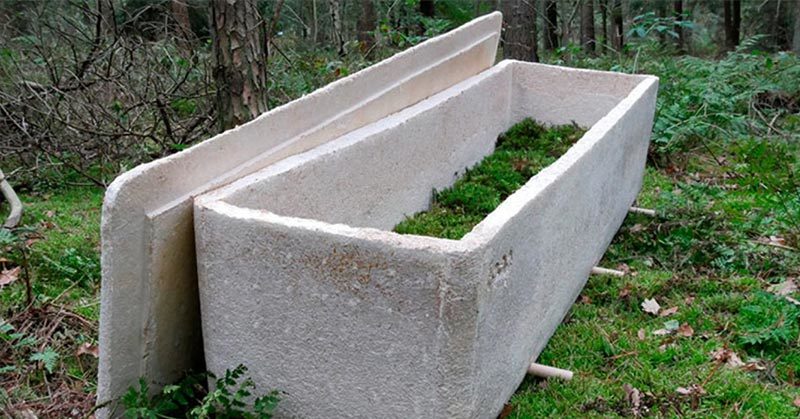Rituals surrounding death are deeply ingrained into our religious and cultural past. Throughout history, humans have gone to great lengths to preserve those traditions, and in almost every culture there is great ceremony surrounding the passing of a loved one.
In many societies, burying the deceased is the traditional way of handling the passing of a loved one. This practice, however, has environmental consequences. Embalming, burial, and cremation release toxic chemicals into the air and soil. Maintaining memorial plots requires immense amounts of space and water.
“The best way is to allow your body to feed the earth or ocean in a way that is sustainable for future generations,” says Susan Dobscha, a professor of marketing at Bentley University and editor of an upcoming book about the green-burial industry [1].
One Dutch start-up is allowing you to do just that. With its new “living coffin”, you can ensure that your loved one’s body returns nutrients back to nature.
Read: These Organic Burial Pods Will Turn You Into A Tree When You Die
The Living Coffin
Delft researcher Bob Hendrikx, along with his team at the start-up company Loop, have designed the world’s first living coffin.
Unlike traditional coffins, which are made from wood, Hendrikx made this new coffin from mushroom mycelium. This will allow the body to compost more efficiently while removing toxic substances from the soil. This will enrich the soil in that area, allowing trees and plants to grow [2].
Mycelium is the underground root system of mushrooms. The coffin itself is then filled with a bed of moss to stimulate decomposition.
“Mycelium is nature’s biggest recycler,” explained Hendrikx. “It’s continuously looking for food and transforming it into plant nutrition.” [3]
Mycelium also eats toxins and turns them into nutrients. Hendrikx points to Chernobyl as an example. Mushrooms were used there to clean up the soil after the nuclear disaster.
“And the same thing happens in our burial places, because the soil is super polluted there and mycelium really likes metals, oils and microplastics,” he said [3].
The company grows the coffins at the Delft University of Technology by mixing mycelium with wood chips in the mold of a coffin. They can grow within only one week. After the mushrooms grow through the wood chips, the coffin has to fry. When it is complete, it is capable of holding up to two hundred kilograms.
Read: Forget Coffins or Boxes: This Company Swirls You Into Unique Glass Art Creations When You Die
Giving Back to the Earth
Once you have buried the coffin, it will interact with the ground water and dissolve within thirty to 45 days. The researchers estimate the body will then take only two to three years to decompose, compared with the ten to twenty years it takes with a traditional coffin.
“[The living coffin allows] people to become one with nature again. We can enrich the soil instead of polluting it,” said Hendrikx [4].
Once the living coffin is in the ground, you can water it, plant seeds, and decide what kind of tree you want to become.
“This coffin means we actually feed the earth with our bodies. We are nutrients, not waste.” [4]
The First Funeral
The first funeral using one of Loop’s living caskets took place recently in the Netherlands.
“I didn’t actually go, but I talked to a relative beforehand – it was a moving moment, we discussed the cycle of life,” said Hendrikx [4].
The relative was the son of the deceased. Despite his sadness at losing his mother, he was happy to know that she will return to nature and soon be living like a tree. Hendrikx described it as a hopeful conversation.
Currently, Loop is working with scientists to measure how human bodies impact soil quality. Their goal is to convince policy makers to convert polluted areas into forests, using human bodies as nutrients.
In collaboration with two funeral cooperatives in the Hague, Loop has now made ten coffins, which sell for 1 250 euros (1456 US dollars) each.
As production increases, Hendrikx expects the price of the coffins to drop. He is hoping that mycelium caskets will become “the new normal” [4].
Keep Reading: This Ice Urn floats While Slowly Returning Cremated Remains to Nature
- https://www.businessinsider.com/burying-dead-bodies-environment-funeral-conservation-2015-10#the-embalming-process-is-toxic-1
- https://www.designboom.com/design/living-coffin-mushroom-mycelium-human-nutrients-nature-09-18-2020/
- https://www.cbc.ca/news/technology/living-coffin-1.5735124#:~:text=Loop%20Cocoon%20casket%20is%20made,underground%20root%20structure%20of%20mushrooms&text=Esther%20Verkaik%2FReuters)-,A%20Dutch%20startup%20has%20created%20a%20biodegradable%20%22living%20coffin%22%20made,into%20key%20nutrients%20for%20plants.&text=Mycelium%20also%20devours%20toxins%20and%20turns%20them%20into%20nutrients
- https://www.theguardian.com/society/2020/sep/15/first-funeral-living-coffin-made-mushroom-fibre-netherlands

